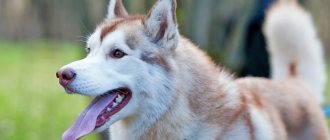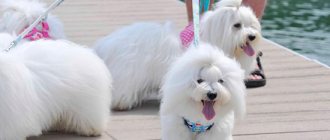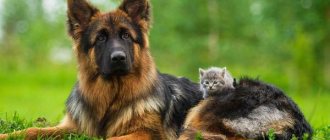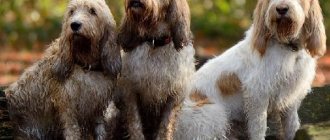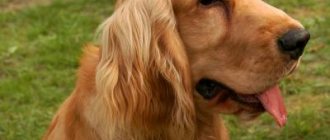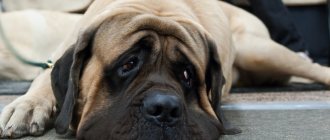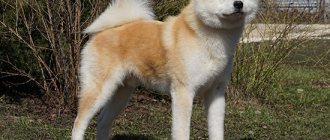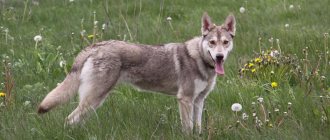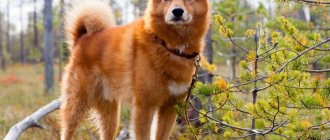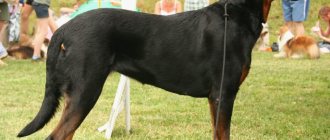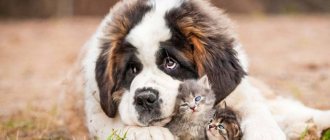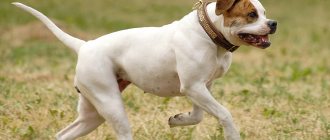Breed card
- Famous breed names: Finnish Spitz, Finnish Laika, Karelian Laika
- FCI breed number: 49
- Description of the standard on the FCI website: link
- Height at the withers: females - up to 47 cm, males - up to 42 cm
- Weight of an adult dog: males - up to 13 kg, females - up to 10 kg
- Color options: red
- Lifespan: up to 15 years
- Puppy cost: 10,000-45,000 rubles
- Size: 3 out of 5
- Learning ability: 4 out of 5
- Attitude towards children: 4 out of 5
- Shedding intensity: 4 out of 5
- Protective and guard qualities: 3 out of 5
Main characteristics
| Breed parameters | |
| Country of origin: | Finland |
| Weight of the breed: | males: 11–13 kg, females: 6–10 kg |
| Height at withers: | males: 42–51 cm, females: 37–46 cm. |
| Temperament: | active |
| Wool: | average |
| Role in human life: | hunting, companion |
If you need a brave, cheerful, faithful assistant in matters of hunting, then the Karelian-Finnish Laika is what will suit you one hundred percent. This dog is known for its compact size, agility, and ingenuity. The pet will adore a kind and fair owner and protect in the most depressing situations. But at the same time, excessive emotional dependence on a person is alien to her. Some breeders recognize that the breed exhibits royal pride and self-esteem. At the same time, dogs are partial to all kinds of practical jokes and active games.
Characteristic
According to the Finnish Laika standard, the dog is a hunting dog, mainly for small game, predators and some birds. By nature, the husky is passionate and independent; it can enthusiastically pursue prey for hours.
In Scandinavian countries - Norway, Finland, Switzerland - working qualities are tested for representatives of the breed. In the rest, they are limited to assessing the exterior.
FCI breed standard: No. 49
The Finnish Spitz is a dog of medium height and lean build, strong and muscular. The standard length of the body is equal to the height. The posture is proud, the movements are free - the transition from trot to gallop and back is natural. The dog is able to change the pace of movement sharply, accelerating and slowing down if necessary.
The energetic and courageous Karelian-Finnish Laika looks proportional. When viewed from above, her head resembles an oval, widening towards the ears. The ratio between the cranial and facial zones is 4:3. The lines of the muzzle and skull run parallel to each other. The frontal groove is weakly expressed, the stop is marked, but not protruding. The muzzle is narrow and dry, tapering noticeably toward the nose. The lobe is black, charcoal. The jaws and teeth, forming a scissor bite, are covered by thin but dense lips, brightly pigmented black. The dental formula is complete.
The cheekbones are weakly filled, only slightly pronounced. The eyes are almond-shaped, medium in size, set slantingly. The look is lively and attentive. The husky's ears are small, set vertically, high on the skull, directed forward. The shape of the ears is pointed, the thickness is medium.
The neck is muscular, without dewlap; in males it looks short due to the voluminous collar. The withers are clearly defined and flow into a short back with a muscular loin. The back ends with a medium-length croup, slightly sloping and well developed. On the rump there is a tail, curled into an energetic ring thrown over the back.
The sternum of the Finnish Husky is deep, with curved ribs, flowing into a tucked belly. The front legs are set parallel and straight, with strong shoulders and elastic wrists. Hindquarters - with wide hips and low hocks.
Disadvantages of the breed:
- weighted head, rough facial part;
- weak lower jaw;
- ears set at an angle;
- tail, undertwisted or twisted;
- sharp color transitions in color.
Serious defects leading to exclusion from breeding:
- soft rounded ear tips;
- broken tail;
- white “socks” on the paws or large spots on the chest;
- color in color, sharply different from the general shade;
- wavy coat;
- under/undershot;
- blue or amber eyes;
- nose of any color except black;
- aggression towards people.
This is the standard description recognized by the RKF for the Finnish Laika.
Russian breeders distinguish the Karelian-Finnish variety from the Finnish Spitz by the following indicators:
- more stretched body;
- the shape of the head when viewed from above is triangular, not oval;
- flat skull;
- the stop is less pronounced;
- the ears are larger than those of the Finnish Spitz;
- the tail is curled into a tight ring, sometimes double;
- brown nose is acceptable;
- White spots in color are acceptable, fawn color is acceptable.
Dimensions, weight and height of the breed
The height of the Karelian-Finnish husky is 47 cm for a male or 42 cm for a female. Deviations in both directions of 3 cm are allowed.
Ideal weight for the breed:
- 12-13 kg – males;
- 7-10 kg – females.
Possible colors
The Finnish husky's coat is of moderate length and lags behind the body due to the abundant undercoat. On the head and limbs it is shorter and fits more tightly to the skin. The guard hair is coarse, the undercoat is soft and downy.
Color – red. At the same time, the fur on the back is bright, golden-red, and on the ears, throat, sternum and belly it is lighter. A white mark on the chest is allowed.
Puppy weight by month
Karelo-Finnish huskies vary in size. One litter can contain puppies of different parameters. Each individual’s development is individual, but breeders offer tables of average puppy measurements for reference.
Weight-for-age ratios:
- 1 month – 1.2 kg;
- 4 months – 3.1 kg;
- 6 months – 5.1 kg;
- 8 months – 7.5 kg;
- 10 months – 10 kg;
- 12 months – 11 kg.
The values may differ depending on the puppy’s genetics and living conditions - take regular measurements for your pet and write them down in a notebook to track development and adjust the baby’s nutrition in time.
Lifespan
Finnish huskies are hardy dogs that can live up to 15 years with good care. Take your dog for a veterinary examination every year, feed it according to the diet and walk it according to the schedule. A grateful pet will delight you with excellent health until old age.
Allergenicity
The Karelian-Finnish husky does not emit a “dog” smell, but its fur, skin or sebaceous secretions can cause allergies. Before purchasing a Laika, check your body’s reaction to allergens and visit the Karelian breeder, asking to arrange close contact with the dogs for the whole day. If there is no reaction, feel free to buy a puppy.
Pros and cons of the Karelian-Finnish Laika breed
A properly raised husky causes virtually no inconvenience. She is unobtrusive, can occupy herself, and does not need constant attention. The dog loves children and other pets, but tends to demonstrate leadership qualities. You should not leave her with kids unattended.
Among the advantages of the breed: mental stability, cleanliness, easy-going behavior, minimum grooming, versatility, good health and stable immunity, longevity.
The disadvantages include: willfulness, stubbornness, a tendency to lead, excessive appetite, difficulty in training.
History of the breed
Karelian Laikas have been bred in the USSR since 1953, mainly for hunting. In some regions they were crossed with Finnish Spitz, which is why the breeds were subsequently combined into one. In 2006, the Russian Canine Federation and the Finnish Kennel Club agreed to adopt a common breed standard. The Spitz was taken as the basis, so most Karelian Laikas did not end up in breeding. And those who got there began to be called Spitz - they were given documents that indicated their Russian origin, but the name of the breed was changed.
Today, connoisseurs of Karelian-Finnish huskies claim that the influx of Finnish Spitz blood was controlled, and the cases of mating were isolated. They use their own standard of the Karelian-Finnish Laika, where the differences from the Spitz are clearly stated. As a result, the breed of “Karelian” is listed in internal documents, and the breed of Finnish husky is listed in international passports.
A set of documents and a request for recognition of the breed have been sent to the RKF - all the requirements necessary for inspection have been met. However, the organization is in no hurry to include Laika even in the pre-recognized category. Therefore, for now, experts rely on the Finnish Spitz standard.
Description of the breed
Initially, the Karelian Laika was engaged in catching foxes, martens, squirrels, hares and game. However, some hunters manage to train dogs for larger animals, including bears.
In addition to its memorable appearance, the Finnish Spitz has unique qualities. The animal does not rely only on itself, but is accustomed to working in a team with a person. The dog is perfectly trainable and follows even the most complex commands. Some owners even say that the animal has a sense of humor.
The Finno-Karelian husky loves to be close to its owner, play or just lie at a person’s feet. It's hard to find a more loyal animal.
Attention! However, the positive qualities of the breed are not limited to hunting. Spitz is no less a good guard and just a friend.
The Ultimate Hunter
Character
The Karelo-Finnish Laika has a set of qualities necessary for a first-class hunter. She has excellent instincts and a sufficient amount of independence in her character. The dog does not need the control of a trainer - it evaluates the situation and makes decisions independently.
When hunting, the dog is versatile - it can drive prey under the gun or run it down on its own and notify the owner about the location of the animal or bird.
In breeding the Karelian-Finnish Laika, special attention was paid to the following qualities:
- endurance;
- enthusiasm, energy;
- aptitude for training;
- good sense of smell;
- excellent hearing;
- skill and dexterity.
Laika fully meets the requirements for the breed - it is friendly, peaceful and active. The dog gets along well with household members and other pets. She is quite inquisitive and explores new territory. She becomes attached to her owner, but remains independent.
The dog remains a puppy until 4 years old, so it is easy to train even at an old age.
How to choose a puppy
It is better to purchase a CFL puppy at 2-3 months of age, but then you will have to tinker with the maintenance and training of a small dog. Grown-up dogs can only be purchased if they have completed a course of primary education and training.
There are not many breed clubs for the Karelo-Finnish Laika in Russia, which is why the breed’s population is small. It is difficult to purchase such a dog from a private person, but it is for the best. After all, in official nurseries they will present all the necessary documents for the puppy, talk about the conditions of its detention, and show the parents.
They advise taking CFL girls. They are not as stubborn and willful as males, and rarely strive to take a leading position in the house.
Puppies must meet all characteristics and have no congenital pathologies. The price depends on the status of the parents and the nursery. The average cost is 15,000-60,000 rubles.
The Karelian-Finnish Laika is an amazing working dog that is still really used for its intended purpose. She will become a good hunter, guard, and draft dog, but it will never be possible to turn her into a sofa lap dog.
Learning ability
Training the Karelian-Finnish Laika is a pleasure. The dog is smart, quick-witted and easily remembers commands. However, she is characterized by a certain amount of stubbornness, so training may take several months to perfect the automatic execution of commands.
When training, show your dog your superiority and authority, but do not allow disrespect. Do not take your puppy hunting until he is one and a half years old, until he has mastered the general course of training and coaching. Don’t expect complete obedience even from a trained dog - the husky always remains self-sufficient. It is important to treat her as an equal.
Having learned a set of commands once, do not forget to repeat it so that the dog does not lose its skills. Laikas are not a breed that remembers training for life.
Advantages and disadvantages
Advantages:
- easy to learn;
- excellent working qualities that manifest themselves at an early age;
- good and kind character;
- becomes attached to the owner;
- loves children;
- does not show aggression towards strangers;
- small size.
Flaws:
- not very well suited for apartment living;
- will be bored without stress and work;
- barks noisily;
- requires training and training, without which it can show its complex character.
Owners of Karelian-Finnish Laikas note their high hunting instincts. The working qualities of these dogs can rival those of hounds if properly trained. But without stress, these dogs simply languish within four walls. They need to splash out their energy, if not on real hunts, then at least on its imitation. Are you familiar with this breed? What was your impression?
Content
The Karelian Laika is the smallest of all Laika-type dogs. It is suitable for keeping in an apartment. Having bought a puppy and having received the first vaccinations, provide sufficient walking time.
Need for physical activity
The minimum duration of walks with a Karelian is 3.5 hours a day. Distribute this time into 2-3 walks and follow the regime. During walks, provide your dog with maximum movement so that it burns off its energy reserves. Then the husky will behave calmly at home.
Walk your pregnant Finnish dog as usual until the second half of the term. At this time, you should reduce the duration of walks to two hours a day and moderate the dog’s activity. Towards the end of the term, take your husky outside more often. After giving birth, walk 4-5 times a day for 10-15 minutes.
Appearance care
The Karelian does not need special grooming. The fur sheds twice a year, and the claws wear down on their own.
The main rules for caring for your husky:
- comb twice a week, and daily during shedding;
- wash 1-2 times a year;
- trim claws every month in winter, and as they grow in summer;
- Monitor the condition of your ears and eyes and clean them if necessary.
Nutrition
Feed your husky meat - beef, lamb or turkey. This is a source of proteins. Add porridge to the meat - buckwheat, rice, oatmeal. They supply the dog's body with carbohydrates. Be sure to include vegetables in your diet to provide vitamins. Do not give bones, sweets, or fatty foods.
An alternative to natural products is ready-made food. Choose super-premium sublimates for active dogs, with meat content starting from 25%.
Maintenance and care
The compact size and characteristics of the breed make it possible to take the husky into the house, into a city apartment, but in order to cope with the dog’s energy, it needs to be taken for long walks. Keeping a hunting dog in rural areas does not cause any problems; the husky happily runs around the yard and destroys mice. You cannot put a freedom-loving pet on a chain, as it develops depression.
Caring for the Finnish Spitz's shiny coat, which does not have an unpleasant odor, usually does not cause problems. A clean pet is bathed up to 3 times a year, using a special shampoo, and after being in a lake or river, rinsed with clean water. A healthy husky sheds in spring and autumn, and the dying fur is combed out with a metal comb.
If a dog that tolerates cold better than heat is kept in an apartment, it sometimes sheds constantly. If overfeeding or improper nutrition occurs, dandruff appears, the fur comes out in clumps, loses its shine, and the animal develops allergies.
It is recommended to cut off your pet’s sharp claws at least once a month, treat the ends with a nail file, inspect the paw pads, and disinfect the cracks.
Dust accumulated in the corners of shiny eyes is removed with a damp cloth. If the conjunctival membrane is red and pus is secreted, the husky should be shown to a veterinarian.
The dog's teeth are brushed with a special toothpaste 2 times a week. The auricle is wiped with a cotton swab, which is moistened in warm water.
A lounger is placed in the corner reserved for the husky in the house, and the pet is fed in the kitchen, where it feels like a member of the family. To prevent the Spitz from getting bored when the owner is working, you can keep him busy with toys, balloons, balls.
Reference! During a walk, even a puppy needs to wear a leash; if you are in a bad mood, you should not take an observant dog with you. If a Finnish husky lives in a house, it is not recommended to have guinea pigs or hamsters; the Karelian will start hunting for the animals as if they were game.
How often to feed your pet depends on its age - a 2-month-old puppy is given food 4 times a day, a 7-month-old puppy three times a day, a year - twice in small portions of 60 g each. For a baby, cut the beef into small pieces and mix it with millet, buckwheat, and rice porridge. Pork and poultry bones are prohibited for the Finnish Husky. The Karelian diet includes:
- kefir;
- vegetables;
- dried fruits;
- cottage cheese;
- eggs;
- fish.
If a pet is transferred to dry food, choose premium brands that contain a large amount of proteins and few grains. It is useful to let your Spitz chew raw beef bones. The dog does not refuse the liver and enjoys the kidneys with pleasure.
You can't give your Spitz milk. Once in the intestinal tract of a Finnish-Karelian husky puppy, the product causes fermentation; it is not recommended to feed the small pet porridge seasoned with butter or palm oil.
To replenish the body of the Finnish husky with vitamins, zucchini, apples, carrots, sweet peppers, and cabbage are used. Puppies quickly gain weight, so that the babies do not pass it on, the remaining food must be removed after a quarter of an hour.
Karelka, like other domestic dogs, is vaccinated. Before vaccination it is necessary to remove worms:
- The first time a puppy is given gentle anti-parasite medications is a month.
- The second deworming is performed 2 weeks later.
- Anti-mite treatment begins between May and November.
The vaccine contains components for the prevention of plague and enteritis; these diseases most often kill children. The Finnish Husky is vaccinated against rabies no earlier than 5 months.
Typical diseases of this breed
Laika is a hardy breed, but it is also prone to diseases.
Possible:
- epilepsy;
- cataract;
- allergy.
Breed characteristics
The characteristics of the Karelian Laika (Karelo) breed will be as follows:
- Aggression and anger are at a low level. The animal hardly shows them.
- High activity, dogs need to move a lot.
- In height, an adult reaches 46-50 cm.
- The shedding is strong.
- Health is average, there are genetic diseases.
- High intelligence.
- Well amenable to training.
- Doesn't like to be alone.
- It performs well as a guard and hunter.
Character and training
Karelka is a full-fledged companion. A baby who has barely begun to walk immediately begins to reach out to a person. Accompanying and guarding bipeds has been instilled in the breed for centuries, so there is nothing surprising here. The cheerful nature of the Karelo-Finnish Laika contrasts with the general mood and distrust of strangers. Karelians are not prone to spontaneous aggression, but if necessary they can and will fight. In relation to the family, the breed shows strong affection and a loyal attitude towards children, other dogs and cats. You should not have animals that may seem like prey to your four-legged dog - rodents, mustelids, birds, reptiles, insects.
Training of the Karelo-Finnish Laika is based on the use of its skills. The standard approach associated with coercion and praise will be a failure, since your ward will prefer to chase the crow rather than monotonously follow commands. All training should be carried out in the form of a game, optimally using the dog’s sense of smell and hearing. In fact, this teaching method is even more complex than it looks in theory. The owner must show perseverance and patience, understand that it is better to move forward in small steps than to waste your nerves and stand still.
You may become disappointed in your abilities and decide to seek the help of a professional. When choosing a trainer, give preference to dog handlers who work with a hunting group of dogs. It is also worth thinking about individual training, since in a group there are too many irritants for Laika.
Owner reviews
Sergey
A suitable dog for both the avid hunter and the hobbyist. I bought it more as a friend and companion, since I go hunting extremely rarely, and not every season. The dog has a very developed hunting instinct, this can be attributed to both advantages and disadvantages. In the forest I immediately understood how to behave with birds and wild boars; snakes are easily crushed. But in the city he chases other people’s cats and tries to hunt pigeons. They are great friends with our cat, they are extremely friendly towards other dogs, but they do not allow neighbors and stray dogs near the dacha.
Ilya
I love Laikas very much for their strong character and efficiency. I saw a Finnish Spitz at an exhibition and just fell in love with this breed. I live in a country house, so there are no problems with maintenance. As a result, six months ago I got a puppy. He's almost a year old, he's a great dog. But he is quite naughty, I think he could use a good training course. Now I’m looking for an instructor, but, alas, I can’t do it myself. It turned out that the dog is very capricious; he seems to consider himself the master of the house.
Alyona
My husband got a Karelian-Finnish Laika, and to be honest, I was against it. I heard that you can’t keep such a dog in an apartment, it will feel bad there, and the hair will come out. We came to a compromise by building a booth for Taiga on the open loggia. She spends most of her time there, whenever she wants, she goes into the apartment. It practically does not shed, even surprisingly. I brush it once a week, the dog is simply delighted. Very beautiful, it's true. But in my opinion, he is no different in intelligence, they say that hunting dogs are all like that.
Paul
I bought the dog as a gift for my father, a hunter. We spent a long time choosing the right breed and settled on this one. The puppy turned out to be very smart and playful. Until he grew up, he was kept in his apartment. He got along well with the cat, played with a small child, there were no incidents or aggression. I quickly learned to go to the toilet using a newspaper.
On the first hunt he showed himself worthy. He understands everything that is required perfectly. When buying such a dog, you should understand that this breed is very capricious, sometimes even harmful. It is imperative to educate and train, otherwise in the future it will be very difficult to get rid of such a feature.
The dog can be kept in an apartment; it is quite compact. He chewed on his charger and headphones, but after buying special toys, he stopped encroaching on other people’s things. A very active dog, he doesn’t know fatigue at all, so if you live in the city, you need to walk him a lot, otherwise he rushes around the apartment and gives him no rest. But if he sees that the owner is not in the mood, he does not pester him and tries to be quieter. I gave it to my father a long time ago, but I still miss it, I’ve never seen such a smart animal before, maybe this is a feature of the breed or we just got one, I don’t know.
Maria
The dog is very stubborn and independent, sometimes responds to commands reluctantly, as if doing a favor. Ours eats little, but it doesn’t affect her physical fitness. He loves to walk, watch other animals, and attempts to attack birds. If you let him off the leash, you won’t get enough, you can lure him in any way, but until he gets enough of it, he won’t run, he won’t even come close.
Video
Historical reference
Modern Laikas are extremely difficult to consider separately, since their “genetic trees” are tightly intertwined. In conditions of constant cold, impenetrable forests, wet plains and other climatic conditions, the multinational population of Russia (and not only) bred different types of hunting dogs. Before the concept of Laika arose, four-legged animals were simply called “yard animals” or “domestic animals.” In fact, we are dealing with aboriginal breed lines that were brought to perfection already in the 20th century.
It’s hard to even imagine the scale of work involved in inspecting and selecting producers similar in appearance and character. Nevertheless, such work was carried out, and dog handlers interested in the development of Laek met regularly and adjusted the basic standards. As a result, two breed groups, Russian and European, reached official registration:
- East Siberian.
- West Siberian.
- Russian-European.
- Karelo-Finnish Laika.
- Karelian Bear Dog.
- Finnish Spitz.
- Norwegian black and gray Elkhound.
The Karelian-Finnish Laika dog breed descended from three aboriginal dogs - Finnish, Olonets and Karelian. The resulting Laika had suitable, small dimensions, but the exterior remained “unstable.” To strengthen their external characteristics, early Karelians actively mated with Spitz imported from Finland. Thus, the double name of the breed was formed.
This is interesting! According to the rules of international cynological associations and generally accepted tradition, the breed receives its name from the country of the patron, for example, German Shepherd or English Mastiff. The Karelo-Finnish Laika is a rare case when a dog was “attached” to two territories at once.
Despite the presence, albeit temporary, of an approved breed standard, the massive import of dogs from Finland gave the expected result. Almost all exhibited Karelians were mestizos, which gave rise to an “offensive” on the part of Finnish breeders. The question of uniting the two breeds under one name was first raised in 1984. The Laek Lovers Union decided to assign a single name - Finnish Spitz. Naturally, the decision was challenged and dog handlers expected a rather violent reaction from dog owners. In fact, all registered Karelo-Finnish huskies had to undergo re-registration or were recognized as outbred.
The next dead end was the attempt to register the breed at the International level. The documents were not registered due to the presence of the names of two countries in the name of the breed. This argument turned out to be undeniable, and the Karelo-Finnish Laika shifted its independent existence in favor of the Finnish Spitz.
Despite documented facts, fans of Karelian dogs do not consider their dogs Spitz. The Karelian-Finnish husky is a descendant of serious aboriginal dogs that successfully played the role of bear guards. Spitz dogs are noticeably inferior to the old-type Karelian dogs in terms of working qualities. Fans of the breed defend the position that the admixture of blood is a process of formation of the gene pool. Taking into account the history of cynology, the process of formation of many well-known and recognized breeds began with the production of a mestizo whose working qualities satisfied the breeder.
Health
The statistical indicator of life expectancy for Karelo-Finnish huskies varies between 10–12 years. With proper care and maintenance of physical fitness, four-legged animals live 15–16 years. The breed is characterized by an optimal ratio of size, activity and natural characteristics. It is enough that the Karelian does not have breed diseases.
However, there are still two alarming points:
- Karelian-Finnish Laika puppies are very agile, active and have a hunting instinct. Most often, skills encourage the baby to look for carrion or food waste. After discovering a “treasure”, the puppy wants to fuss around in the “incense” from head to toe, or even chew the find. From the above there are two conclusions - do not delay basic vaccination and walk your fidget in a muzzle. Remember that active immunity is not a guarantee that the dog will not get sick.
- Obesity is a “sore issue” for Karelians, especially if the dog does not hunt. When alone, the four-legged dog acquires the habit of eating out of boredom. In this matter, responsibility lies entirely on the shoulders of the owner. A dog that is so active by nature must receive “feeding” of its physical characteristics - a balanced diet, a good walk, active games, and sports.
